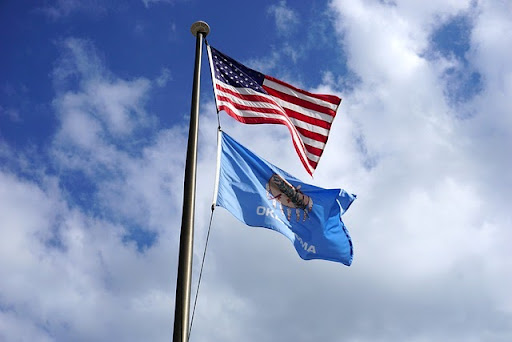Oklahoma cannabis regulations came into effect in 2018 when the Sooner State officially became the 30th state to legalize medical marijuana. Since the passing of State Question 788 in 2018, there have been several updates to the regulations.
If you live in Oklahoma or hope to open a cannabis business there, you need to be familiar with the current Oklahoma cannabis regulations for medical marijuana patients and their caregivers, non-medical marijuana patients, and cannabis businesses.
Medical Marijuana Licenses
In order to access medical marijuana products in Oklahoma, you need a state-issued medical marijuana patient license. Unlike most medical states, there are no specific qualifying conditions—you simply need the signature of a board-certified physician.
To apply for a license under the state’s medical marijuana program:
- Book an appointment with a board-certified physician and obtain their signature if eligible.
- Submit your application with the Oklahoma Medical Marijuana Authority and pay the application fee of $100.
- Purchase the products recommended for your condition at any of the state’s licensed dispensaries.
- See your doctor and complete a renewal application before your medical marijuana card expires.
Please note that a minor can only obtain a medical marijuana card with the signatures of two board-certified physicians and the applicant’s legal parent or guardian.
With a Medical Marijuana License
Once you have a medical marijuana license, you can possess:
- Up to 3 ounces of marijuana on your person
- Up to 8 ounces of marijuana in your home
- Up to 1 ounce of concentrated marijuana
- Up to 72 ounces of edible marijuana products
- Up to 6 marijuana seedlings and 6 mature marijuana plants
A medical marijuana license holder can also designate a caregiver to grow or purchase cannabis for them.
Without a Medical Marijuana License
Medical marijuana law in Oklahoma also provides some support for patients who don’t go through the process of obtaining a state-issued license. If you don’t have a license and are caught in possession of up to 1.5 ounces of medical marijuana, you can get away with a $400 fine and no jail time—as long as you can state an eligible medical condition. No matter how many times you get caught, the fault is still classed as a misdemeanor. However, you will still be charged a fine.
Where You Can Consume Cannabis
Under the current Oklahoma cannabis regulations, you (as a legal patient) can consume marijuana at home but not in public places. If you have a medical marijuana license, you can transport marijuana in your car as long as the packet is closed and out of your reach. However, driving under the influence of marijuana is illegal. Crossing state lines with marijuana in your vehicle is a federal offense even if medical marijuana is legal at your destination.
For Businesses
Since medical cannabis was legalized in Oklahoma, the medical marijuana industry has exploded. In 2020, the sale of medical marijuana products passed $800 million and the number of cannabis jobs in the Sooner State rose to nearly 17,000. Compared to other states, obtaining marijuana business licenses in Oklahoma is a fairly straightforward process. Here’s what prospective business owners in the Sooner State need to know.
Obtaining a Commercial License
The Oklahoma Medical Marijuana Authority issues licenses and license renewals to:
- Growers
- Processors
- Dispensaries
- Transporters
After obtaining local licenses and permits, you can start the application process online and pay the license application fee, which is $2,500 per year plus a credit card processing fee.
Residency Requirement
State Question 788 stipulates that 75% of cannabis business owners must be Oklahoma residents. When applying for a commercial license, you will be asked to provide proof of residency for the past 2 years or 5 continuous years out of the last 25 years. This proof can come in the form of an Oklahoma driver’s license, a state ID, a utility bill (not cell phone or internet), a property deed, or a current rental agreement.
Distance from a School
According to Oklahoma cannabis regulations, cannabis dispensaries must be located more than 1,000 feet from the entrance to a public or private school, including preschools and excluding homeschools, daycare, and childcare facilities. The distance is calculated as the “straight-line distance” rather than walking or driving distance and is confirmed by officials using satellite measuring tools.
Proximity to Tribal Lands
No marijuana business in the state of Oklahoma is allowed to be situated on tribal lands. When applying for a commercial license, the business owner must confirm that their proposed location is not on tribal territory.
Security Requirements
Business owners must pledge not to give marijuana to anyone who is not legally allowed to possess it. In addition, they must implement security measures to prevent the theft of marijuana from a licensed premise or vehicle that is authorized to transport medical marijuana.
Law Enforcer Prohibition
According to Oklahoma cannabis regulations, no “individual with an ownership interest in the business” can be a police officer, sheriff, deputy sheriff, prosecuting officer, or someone who works for the OMMA or the municipality where the commercial entity is situated.
Certificate of Compliance
When applying for a commercial license, you need to have a Certificate of Compliance from your city or county. Business owners are encouraged to approach their city or county for more information about the certificate before applying through the OMMA.
Transporter Licenses
With every commercial license, the licensee is given a transporter license which enables growers, processors, and dispensaries to transport medical marijuana products to other commercial licensees. This license, however, does not enable you to move or store medical marijuana on behalf of other commercial licensees.
Seed-to-Sale Tracking System
Title 310, Oklahoma Department of Health, Chapter 681, Medical Marijuana Regulations lays out the requirements for a seed-to-sale tracking system that would follow each marijuana plant through processing and transport to final sale. Under these regulations, commercial licensees must tag each plant with an RFID tag and enter the details of each medical marijuana plant or medical marijuana product into the state inventory tracking system after each sale or transfer.
Disposal of Cannabis Waste
Cannabis plants and waste generated in the processing of marijuana are subject to Title 310, chapter 681, subchapter 5 of the Oklahoma Administrative Code entitled Medical marijuana waste disposal. Under the updated Oklahoma cannabis regulations, licensees may dispose of:
- Rootballs
- Stems
- Fan leaves
- Seeds
- Mature stalks or their fiber
They can dispose of these plant parts at the licensed premises by:
- Open burning
- Incineration
- Buying
- Mulching
- Composting
- Another technique approved by the Department of Environmental Quality
Other kinds of cannabis waste must be processed or destroyed by a licensed medical marijuana waste disposal facility. Please note that GAIACA is now licensed to process medical marijuana waste in Oklahoma.
As with medical marijuana plants and products, all waste processed onsite or transferred to a licensed waste facility must be weighed and the manner of disposal reported using a form from the OMMA. Commercial, research, and educational licensees must keep marijuana disposal records for a period of five years.
Quality Assurance Program
Cannabis products in Oklahoma can be tested at any of the state’s 23 licensed medical marijuana labs. However, in August 2020, the OMMA contracted the Oklahoma lab Metis to function as a quality assurance lab. To address inconsistencies in testing, Metis has been sending known samples to these 23 labs to see if their results are accurate as far as:
- Potency
- Pesticides
- Microbials
- Solvents
- Heavy metals
- Mycotoxins
The quality assurance lab is also set to conduct lab visits twice a year and sample products at licensed medical marijuana dispensary locations. The purpose of these Oklahoma cannabis regulations is to ensure a consistent standard of testing across the state and quality products for licensed patients.
Other Proposed Regulations
HB1960: Home Delivery of Medical Marijuana
On February 1, 2021, Representative Fetgatter authored House Bill 1960 “authorizing dispensaries to deliver to certain private residences.” On February 2, the bill was referred to the rules committee. It was then withdrawn on February 8 and referred to the Alcohol, Tobacco, and Controlled Substances Committee.
HB1961: Adult Access to Marijuana
On the same day that House Bill 1960 was proposed, a second bill, HB1961 was proposed which would allow Oklahomans to vote on adult-use marijuana for those over 21. Just like HB1960, this bill died in committee and was referred to the House Alcohol, Tobacco, and Controlled Substances Committee.
Oklahoma Cannabis Regulations in Review
Oklahoma’s cannabis regulations are very accessible for medical marijuana patients and businesses seeking to obtain a license. The broad-sweep permission for doctors to prescribe marijuana as they see fit is a particular highlight of The Sooner State’s medical marijuana program, as is the comparatively low entry barrier for growers, processors, dispensaries, and transporters.
The main challenge for medical cannabis businesses is keeping up with all of the required documentation, which makes tracking and recalls easier but may drive up the cost of products. Hopefully, further updates to Oklahoma’s cannabis regulations will clarify the outstanding issues and ensure affordable, high-quality medical cannabis for patients.






